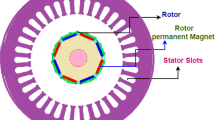Abstract
Zero running emission, sustainability and efficiency of Electric Vehicle (EV) make it appropriate option for future transportation. In-wheel propulsion system of electric vehicles has been one of the main research concentrations in past decades. Brushless DC (BLDC) motor is the most suitable in-wheel motor because of its high efficiency, torque/speed characteristics, high power to size ratio, high operating life and noiseless operation. In this chapter direct torque control (DTC) switching technique with digital pulse width modulation (PWM) speed controller of BLDC motor for drive train system of EV has been reported. Effectiveness of the proposed BLDC motor drive is investigated through simulation and experiment. Obtained results show effective control of torque and remarkable reduction of torque ripple amplitude compare to conventional reported switching techniques. Improvements of in-wheel motor’s torque controllability result to more efficient and safer electric vehicles.
Access this chapter
Tax calculation will be finalised at checkout
Purchases are for personal use only
Similar content being viewed by others
References
Bergsson K (2005) Hybrid vehicle history more than a century of evolution and refinement, http://www.hybrid-vehicle.org/hybrid-vehicle-history.html, Accessed 18 Sep 2012
Tashakori A, Ektesabi M, Hosseinzadeh N (2011) Characteristics of suitable drive train for electric vehicle. In: Proceedings of international conference on instrumentation, measurement, circuits and systems (ICIMCS 2011), vol 2. ASME, pp 51–57
Tashakori A, Ektesabi M (2012) Comparison of different PWM switching modes of BLDC motor as drive train of electric vehicles. (World Academy of Science) J Eng Technol 67:719–725
Tae-Hyung K, Ehsani M (2004) Sensorless control of the BLDC motors from near-zero to high speeds. IEEE Trans Power Electron ISSN 0885–8993, p1635
Lee BK, Ehsani M (2001) Advanced BLDC motor drive for low cost and high performance propulsion system in electric and hybrid vehicles, Texas A &M University, Dept. of Electrical Engineering, College Station, TX 77843–3128, USA
Luo FL, Yeo HG (2000) Advanced PM brushless DC motor control and system for electric vehicles. In: Proceedings of IEEE industry applications conference 2000, vol 2. Singapore, pp 1336–1343
Choi J, Park C, Rhyu S, Sung H (2004) Development and control of BLDC Motor using fuzzy models. In: Proceedings of IEEE conference on robotics, automation and mechatronics 2004, vol 2. Singapore, pp 1180–1185
Rodriguez F, Emadi A (Oct. 2007) A novel digital control technique for brushless dc motor drives. IEEE Trans on Industrial Electronics 54:2365–2373
Tashakori A, Ektesabi M (2012) Direct torque controlled drive train for electric vehicle. In : Proceeding of the world congress on engineering, WCE 2012. Lecturer notes in engineering and computer science, London, UK, 4–6 July 2012, pp 948–952
Takahashi I, Noguchi T (1986) A new quick-response and high-efficiency control strategies of an induction motor. IEEE Trans Ind Appl 22(5):820–827
Depenbrock M (Oct. 1988) Direct self-control of inverter-fed induction machine. IEEE Trans on Power Electronics 3(4):420–429
Ozturk SB, Toliyat HA (2007) Direct torque control of brushless dc motor with non-sinusoidal back-EMF. In: Proceedings of IEEE international conference on electric machines & drives, vol 1. IEMDC, pp 165–171
Oz turk SB, Toliyat HA (2008) Sensorless direct torque and indirect flux control of brushless dc motor with non-sinusoidal back-EMF. In: proceedings of 34th annual conference of IEEE on industrial electronics IECON 2008, pp 1373–1378
Yang J, Hu Y, Huang W, Chu J, Gao J (2009) Direct torque control of Brushless DC motor without flux linkage observation. In: proceedings of IEEE 6th international power electronics and motion control conference IPEMC 2009, pp 1934–1937
Wei-Sheng Y, Hai L, Hong L, Wei Y (2009) Sensorless direct torque controlled drive of brushless DC motor based on fuzzy logic. In: Proceedings of 4th IEEE conference on industrial electronics and applications ICIEA 2009, pp 3411–3416
Gupta A, Taehyung K, Taesik P, Cheol L (2009) Intelligent direct torque control of brushless dc motors for hybrid electric vehicles. In: Proceedings of IEEE conference on vehicle power and propulsion VPPC, pp 116–120
Ozturk SB, Toliyat HA (April 2011) Direct torque and indirect flux control of brushless dc motor. IEEE/ASME Trans Mechatron 16:351–360
Vas P (1998) Sensorless vector and direct torque control, Oxford University Press, 1998
Hu J, Wu B (1998) New integration algorithms for estimating motor flux over a wide speed range. IEEE Trans Power Electrons 13(5):969–977
Zhong L, Rahman MF, Hu WY, Lim KW (1997) Analysis of direct torque control in permanent magnet synchronous motor drives. IEEE Trans Power Electron 12(3):528–536
Sathyan A, Milivojevic N, Lee Y, Krishnamurthy M, Emadi A (2009) An FPGA-based novel digital PWM control scheme for BLDC motor drives, IEEE Trans Ind Electron 56(8): 3040–3049
Tashakori A, Ektesabi M (2012) Stability analysis of sensorless BLDC motor drive using digital PWM technique for electric vehicles. In: Proceedings of 38th annual conference of IEEE on industrial electronics, (IECON 2012) (accepted), Montreal, Canada, 25–28 Oct 2012
Author information
Authors and Affiliations
Corresponding author
Editor information
Editors and Affiliations
Rights and permissions
Copyright information
© 2013 Springer Science+Business Media Dordrecht
About this chapter
Cite this chapter
Tashakori Abkenar, A., Motamed Ektesabi, M. (2013). Direct Torque Control of In-Wheel BLDC Motor Used in Electric Vehicle. In: Yang, GC., Ao, Sl., Gelman, L. (eds) IAENG Transactions on Engineering Technologies. Lecture Notes in Electrical Engineering, vol 229. Springer, Dordrecht. https://doi.org/10.1007/978-94-007-6190-2_21
Download citation
DOI: https://doi.org/10.1007/978-94-007-6190-2_21
Published:
Publisher Name: Springer, Dordrecht
Print ISBN: 978-94-007-6189-6
Online ISBN: 978-94-007-6190-2
eBook Packages: EngineeringEngineering (R0)




